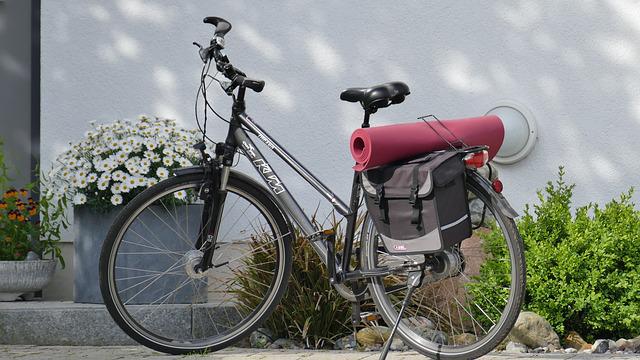How do you fix a flat bike tire? A flat tire must almost always be repaired or replaced in order to fix a bike tire. Flats are brought on by leaks or holes in the inflated rubber tube that sits between the rim and the tire. The tube must be taken out, repaired, or replaced, and then the wheel and other components must be reassembled in order to solve the issue. Although it may seem difficult at first, cycling requires the mastery of this skill, which is actually quite simple.
Table of Contents
Why Bike Tire Keeps Going Flat
Nobody enjoys a flat tire that keeps blowing. It ultimately puts your safety at risk and is a major roadblock. A flat tire requires you to slow down and give your bike some extra time to be inspected and fixed.
Your bicycle tire may go flat for a number of reasons. The following are the main causes of your flat bicycle tires:
1. Glass shards
Glass shards are brittle, powerful objects that easily pierce through any material. They harm many people, especially pedestrians and cyclists because they are frequently invisible on the road. You can easily walk right by it without noticing. The material punctured your tire and it started to deflate the moment you realized it.
So when biking, it’s crucial to pay close attention. Broken glass is likely to be present in the lane if there are any shiny materials; this could harm your bike tire.
2. Goatheads and thorns
Goatheads and thorns are additional offenders. Goatheads are spike balls that were born in plants and can quickly pierce your tire. They are caltrops that cling to your tires and eventually rip them.
Goatheads are less noticeable on the road than broken glasses. They are hard to see while biking because of their color, which easily blends with the surroundings. Avoid riding near the trial’s edges because there are more goatheads there.
3. Pinch flats
On the edges of your bike tube, there are tiny holes known as snake bites or pinch flats. They happen as a result of the tube being squeezed repeatedly between the road and the bike rim. When you ride quickly, it typically happens. Given the lack of pressure needed to keep the rim off the ground, underinflated tires are where most pinch flats begin.
4. Tire wear
Overuse of your bicycle can also result in flat tires, which require you to change a bike tire without tools. Your tire grows tumors as a result of wear, even if you are not aware of it. Bicycle tires without rubber to shield the inner tube are those that have been ridden to the cords. Sharp objects can therefore easily pierce the material.
Steps To Changing Your Flat Tire
You can change a flat bike tire and get back on your bike in just 10 minutes with the right tools and a little know-how. This is the detailed instruction manual.
Read about: How Much Does A Bike Cost? A Closer Look – Bike Your Best
Taking The Wheel Off The Bicycle
For the wheel to be elevated while you work, use an upright bike stand. To avoid scratching the saddle and handlebars, place an old towel or piece of cloth beneath them before working on the bike if necessary.
With a wrench, unfasten the nuts on the wheel axle. If a wrench or ratchet won’t budge the nuts, try silicone spray or even cooking spray. Some more recent bikes have much easier, quick-release wheel latches; in this case, simply open the latch without removing the wheel first.
If the brakes are an obstruction to removing the wheel, disconnect them. The brake calipers or the hand brake lever frequently have a quick release, though there are many different brake mechanisms with various releases. Alternately, you might need to squeeze the brake calipers in order to release the cable. If you have access to one, look through your bike’s instruction manual or conduct a web search for the brake or bike’s manufacturer.
If you need to remove the back wheel, pull the chain out of the way. By changing the gears, you can give the chain more slack. Shift until the chain is on the pedal spindle’s innermost gear and the outermost gear on the rear wheel. When changing gears, pull back on the rear derailleur to make the chain pull away from the cogs on the cassette (gear disc).
Slide the wheel off the bike. The front wheel’s axle needs to be gently guided out of the forked slot holding it to the frame now that the nuts or quick-release are unfastened. On an upright bike, you must, however, more carefully direct the rear wheel past the chain and any other obstructions. To move the chain away from the wheel, keep pulling back on the rear derailleur.

Pulling The Tube Partially Out
It is necessary to locate the hole before removing the flat tube entirely. If not, the item might still be inside your tire, waiting to pierce your new tube when you get back on the bike.
Pull the tube out of the tire completely, starting at the valve stem and leaving just 2 or 3 inches on either side. After locating the hole, you can align it with the tire to determine if the problem that caused your flat tire is still present. To ensure that you fix your flat bike tire once from the original cause, it is crucial to identify the cause.
Finding The Hole And Removing The Culprit
Use a hand pump to slightly inflate the flat tube so that it is partially exposed in order to hear where the air is leaking. If you have trouble hearing it, put your hand or face close to the tube to feel the air escaping. If you’re reasonably certain that a bump rather than something sharp was the cause, Darryl advises skipping this step.
When you locate the hole, align it with the tire to identify and eliminate the offender. Typically, the tire will be prepared to hold a new tube, according to Coach Darryl. However, if you do happen to have a damaged side wall, you can cover the hole to stop the new tube from squeezing through and going flat with an old piece of tire or even a folded dollar bill. Mind you, this isn’t a replacement for a new tire; it’s just enough to get you home or to a bike shop.
Removing And Replacing The Tube
You can fully remove the old tube once you’re certain there is nothing left in your tire that could damage your new tube. Just enough air should be blown into the new tube before you start inserting it to give it its typical shape. When you seat it inside the tire, this will prevent it from becoming twisted or folded.
Once it’s partially blown up, start by seating the valve stem where it fits, then work your way around from both sides of the valve to get the tube all the way inside the tire.
Putting The Tire Back On Your Wheel
Repairing a flat bicycle tire is most difficult at this stage. This time, you’ll start at the valve and push it up from the inside of the tire, raising it higher than it would be on the ground. This will provide you with enough room to first wrap the tire around the rim at the valve stem.
Now work your way around the stem from both sides, ending at the furthest point away from it. The hardest part will be pushing the tire onto the wheel will be the final 8 to 12 inches, so Darryl advises wearing gloves and pushing with your palms rather than your thumbs. Thumbs are much weaker than hands, and gloves will shield your palms.
Coach Darryl advises against doing this because you could accidentally pinch your tube while attempting to move the last few inches with your tire levers.
Inflating The Tire
It’s time to inflate your tire so you can see if your efforts were successful. You can accomplish this using a minipump, a CO2 cartridge, or both. You should ultimately select the inflation method that is most comfortable for you because each has advantages and disadvantages. Put both on you, if you can.
CO2 cartridges are very efficient, especially when your goal is to inflate to higher pressures, but they are one-time use only, so there is no way to reuse them. Use a CO2 cartridge to practice tire inflation at home so that when the inevitable happens, you don’t blow out your tube or use up the cartridge and end up stranded. Making sure the inflator is securely fastened to the valve stem is essential when using a CO2 cartridge.
Even though a minipump is not as simple to use as a CO2 cartridge, it is still strongly advised to have one in your toolbox so that you always have a backup method for tire inflation. Having a pump with a hose is also strongly advised because it enables you to push the pump against the ground for better leverage, enabling you to achieve higher pressures; pumps that attach directly to the valve stem don’t offer this advantage and may result in damage to the valve stem or even the rim when used incorrectly. It is also possible to find mini pumps that combine CO2 inflators.
Check the bead several times to make sure it’s seated correctly in the rim as you inflate the tire to the desired PSI. Reattaching your wheel should only be done once you’re certain that everything is in the right spot.
Installing The Wheel
It’s time to install the wheel last but not least. As long as you know how to complete the task successfully, replacing the front and back wheels are not particularly harder than each other.
After aligning the fork dropouts with the wheel axle, carefully lower the fork onto the axle to attach the front wheel. Check that the axle is properly positioned in the dropouts by gently pressing down on the handlebar. It’s crucial to keep in mind that the quick release or thru-axle lever is located on the opposite side of the drivetrain and does not touch the frame. When tightening the bolt, keep the quick release lever in place. Simply open the lever and further tighten the bolt if you discover that it closes too easily or comes into contact with the frame. You should only tighten the bolt up to the point where you can close the quick lever firmly without having to use excessive force. Be careful not to overtighten the bolt. Don’t forget to reconnect, adjust, and test the functionality of your bike’s rim brakes.
If your flat happened on the back wheel, make sure the frame dropouts are aligned with the axle and wrap the top of the chain around the cassette’s smallest cog. Be careful not to interfere with the derailleur by pulling it back and down as you gently push the wheel into the frame. If the wheel is difficult to insert, take it out and give it another go. When you’re certain the wheel is in the right place, either thread the thru-axle into the frame and hub or close the quick release (and engage any rim brakes, if necessary). Lifting the rear wheel and spinning the cranks will be the last check to see if your bike is ready to continue its journey. You can be sure you’re in good shape if everything goes without a hitch.
Conclusion
Do you know how to fix a flat bike tire? No matter the style of riding, flat tires are an unavoidable part of cycling. With some simple tools, some know-how, and lots of practice, changing a flat bike tire is easy. It will become more routine as your practice. This article walked you through the procedures for changing your bike tire and fixing a flat, with information on changing both the front and rear tires.
Always have a spare tube, repair kit, tire levers, a multi-tool, a bike pump, or a C02 inflator with you when you ride your bike, and follow these easy instructions to get back on the road quickly.



